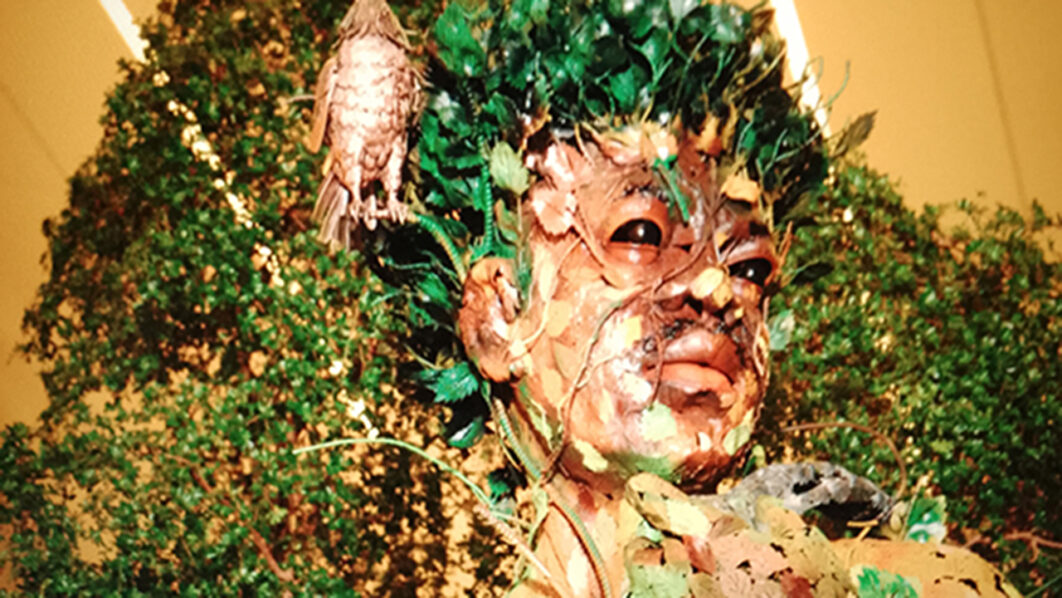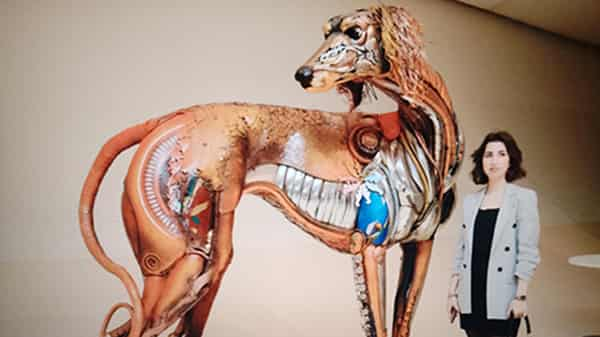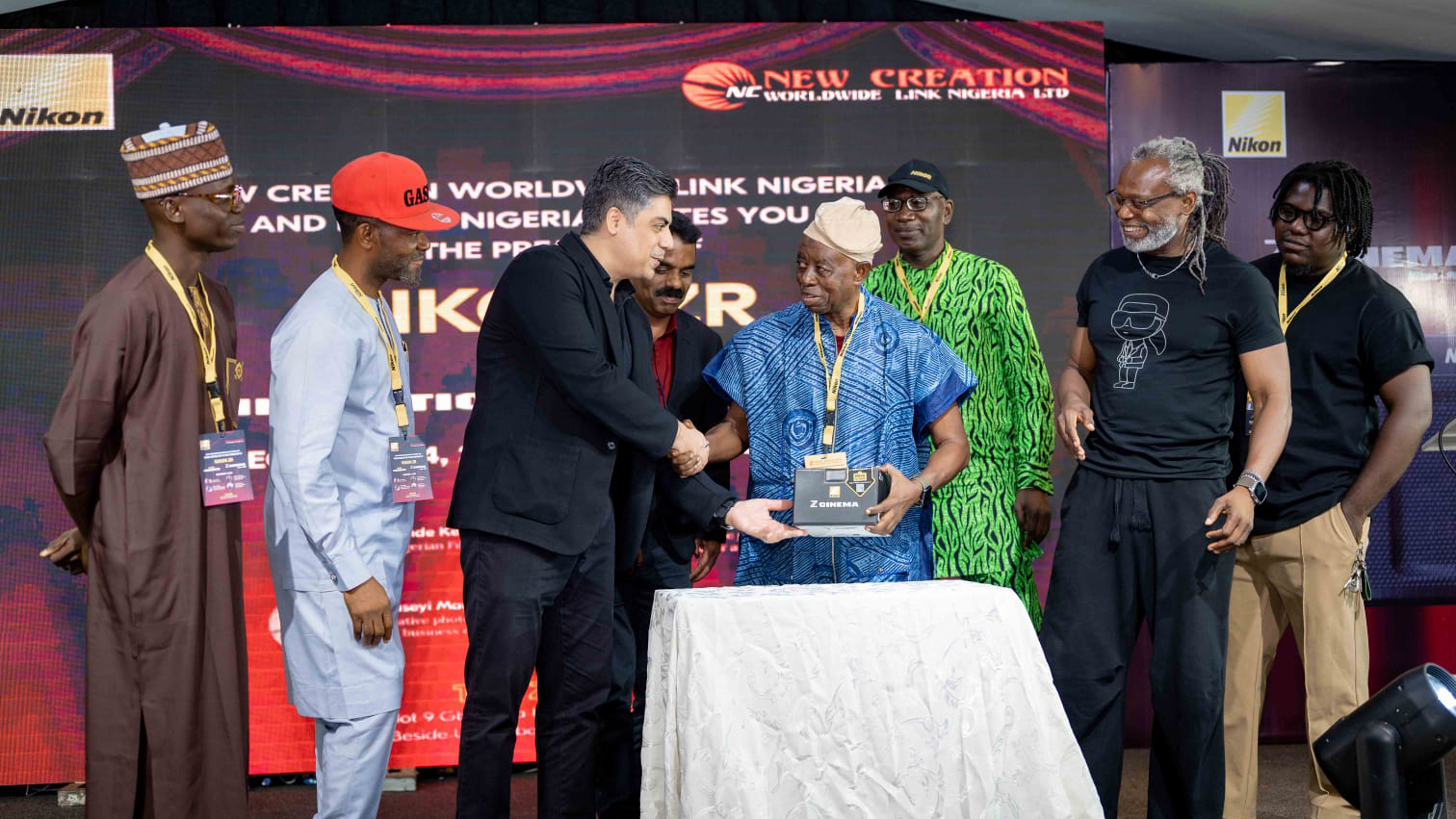
Heydar Aliyev Center, Baku, Azerbaijan, is currently hosting the exhibition of Nigerian sculptor, Dotun Popoola. The solo show is titled, Reclaimed Beauty.
The show, which opened ahead of COP29, is Popoola’s seventh solo exhibition, emphasises the need to pay attention to the climate.
The show, with over 20 exhibits, is expected to end in October 2025. Through the works created from metal waste, Popoola draws attention to the main problem for humanity – climate protection and the importance of caring for the environment.
The works created by the author are a tribute to the human imagination, which can create beautiful examples of art from ‘nothing’ turned into waste. Popoola’s Reclaimed Beauty aligns with Azerbaijan’s ‘Green World Solidarity Year’ and resonates with themes of environmental awareness and climate change.
Since 2012, the country has been holding the international festival ‘From Waste to Art’ with the support of the Heydar Aliyev Foundation, the purpose of which is to attract the attention of the general public to environmental issues.
Popoola has represented Nigeria in various art exhibitions, as well as the Metal Art Exhibition in Qatar in 2019, the Global Arts Festival in the Indian state of Gujarat in 2020, Be Together (Coexistence) in Turkiye in 2021, and other exhibitions.
Speaking during a panel session with key stakeholders on climate change in Nigeria, he shared his journey of transforming discarded materials into luxury goods valued at billions of Naira. He highlighted his efforts at saving tons of waste from dumpsites and junkyards across various states in Nigeria and globally.
“Additionally, I discussed my role in mentoring young recyclers and building a movement of environmental activists committed to sustainability. One of the major highlights of the conversation was his upcoming collaboration with the Osun State government to transform the Onibueja dumpsite within the Osun Metropolis into a green hub.
“This vision aims to create a ‘Mini Disney’ in Osun, utilising resources within the state and supports from private sectors and the Federal Government of Nigeria.”
According to Michael Olusegun Fajuyigbe, in his Dotun Popoola: The Aesthetic Explorer and the Quest for Ecological Sustainability, said: “Popoola is a synergetic metal sculptor who has carved a niche for himself with his monumental metal sculptures. Rising from a state of hopelessness, he has become a beacon of hope, dedicating himself to serving humanity through his artistic practice and community services. He is passionate about transforming lives through his artistic and leadership skills, turning trash into treasures, rubbish into rubies, and waste into wealth.”
Art historians and scholars such as Moyo Okediji, Olusegun Fajuyigbe, Kunle Filani, Kehinde Adepegba and Tolulope Sobowale believe his works have evolved beyond the tropes of traditionalism and embraced transformative and global cultural approach to solving human developmental issues, as his monumental sculptures deliberately connect viewers to past values; explores human achievements and realities; celebrate nature, animals, birds, and plants; and document environmental issues.
Over the years, he has reimagined and repurposed discards, particularly, non-degradable junks and transform them into aesthetic objects that provide pleasure to the eyes and challenge the intellect. Viewers often wonder and scream for joy at the sight of his hyper realistic monumental sculptures.
A master of artistic possibilities of upcycling, Popoola explores materials and their potential beyond their initial purpose to directly engage with themes of sustainability, waste management and ecological issues. His synergetic sculptures represent an exploration of form, material, and cultural identity, blending artistic and technical elements in ways that challenge conventional perceptions of sculpture and extend form and meaning in art. In this sense, Reclaimed Beauty is an outcome of Popoola’s continuous search for innovations and identity; while repositioning the role of contemporary African art in global discourse.
“Popoola combines discarded metal materials, stamping them with his own intricate design techniques; creating large-scale sculptures that are not only visually striking but also rich in narrative. His synergetic approach, which combines various elements of art and engineering techniques, reflects how discarded industrial materials can be transformed into vibrant and evocative art of great value,” he said.

Popoola has made so much variety of this genre that keeps the viewer wondering where the boisterous creative ingenuity is emanating from. In fact, the artist’s hybrid sculpture, installed at the centre stage of the Nigeria pavilion at Dubai Expo 2020, also attracted the attention of visitors.
The works created mainly from household waste demonstrate the possibility of turning even waste into a work of art. This is the resultant effect of Popoola’s steadfast and vast experience, consistent and persistent in creativity, audacious and courageous in executing transcendental larger-than-life works that are not only mouth-opening but awe-inspiring as well.
Fajuyigbe said, “Popoola shares affinity with the greats through his depiction of form with unprecedented realism and emotional depth, thereby, elevating art into a profound investigation of humanity and human social environment.” He graduated from the Obafemi Awolowo University, where he bagged his BA and MFA degrees with specialisation in sculpture and painting in 2008 and 2014 respectively.
“His works embodies a visual culture that centres on aesthetic exploration of human activities, culture, history and global issues on environmental awareness and sustainability. Popoola’s synergetic approach to art making, the cultural and symbolic depth of his themes, his engagement with traditional styles and techniques, and environmental awareness regarding waste management through art, constitute the key aspects of his aesthetic exploration.”
Writing on Reclaimed Beauty: Dotun Popoola’s Neo-Metal Art of Revivification, a piece in the brochure to the show, Kehinde Adepegba of the Department of Art and Industrial Design, Lagos State University of Science and Technoology, Ikorodu, said Popoola celebrates advancement in the art of revivification.
He noted that neo-metal-art is the dimension of metal construction introduced into Nigeria by Popoola as influenced by John Lopez of South Dakota USA, his mentor, whereby scraps of metal are welded together in whole and in parts to create highly compositional artwork in naturalistic forms and painted in realistic colours sometimes retaining the original colours of some of the metal scraps. This is achieved by collection, separation, assemblage, cutting, beating, tracing, welding, grinding, spraying, sandblasting, anti-rust application, and burnishing of the metal elements.
He continued: “Yes, the art has been variously referred to as the art of recycling, repurposing, up-cycling, reusing and hybrid; but revivification is carefully selected and used here to accentuate the transformative, life-giving, resourceful and multi-procedure of ‘bringing again into activity and prominence’ objects that were once disused, discarded or once upon a time regarded as scraps.”
Subsequently, as a role model, Popoola has lit the paths of many budding artists who were influenced by this neo-metal art, and they no longer grope in the dark alleyways of art.
“Popoola’s expressive neo-metal art since 2018 with Irin Ajo, when he delivered himself from artistic proto-typing, has underscored artistic imaginations, constructions and reconstruction, location and relocation, assemblages, and installations marrying culture with technology,” Adepegba remarked.
“These multiple procedures validate the restitution of metal scraps rescued from dumpsites thus turning rubbish into rubies, trash into class, abasement into advancement, and gory into glory. His experience in this neo-metal art has shaped and reshaped the sculpture art landscape in Nigeria.”
Reclaimed Beauty showcases 20 new enthralling works signaling advancement in Popoola’s creative oeuvres and ventures. This exhibition, as usual, projects cross-cultural nuances of the artist exposing his inclination to history, nature, culture, humanity, and entertainment. “Works are now more colourful than earlier ones suggesting better finishing thereby producing a photo-finish striking outlook. The works are also more intricately executed giving the impression that metals are malleable like plastics in the hand of the artist,” said Adepegba.
The balance of old and new, local and global is at the heart of Popoola’s creative journey in Reclaimed Beauty. The theme deepens an introspective understanding of language, culture, form, motifs, symbols, colour scheme, and values as the basis for appreciating changes and persistence in contemporary African art.
In his Ajala Travels, he documents the life of a Nigerian known as Moshood Adisa Olabisi Ajala (1934 – 1999), who traveled all over the world using a Vespa scooter. Ajala, as popularly known, hailed from Iseyin in Oyo and achieved his ambition of traveling across the world in a trip that ended in 1963.
Ajala travel serves the purpose of achieving a history and personality. More than that, the artist tries to make people remember that what you put into the world is what you get from it. If it was possible for Ajala to travel the world on a scooter, it would be possible for anyone to follow his ambition by believing in him or herself.
Generally, and particularly in Reclaimed Beauty, many of Popoola’s sculptures “draw inspiration from African wildlife, Nigerian folklore, and cultural symbols. In doing so, he explores the intersection between contemporary art and traditional African aesthetics, reinterpreting cultural motifs through modern materials. For example, his animal sculptures, like horses, bulls and elephants are often infused with symbolic meanings related to strength, grace, wisdom, and resilience, which resonate with African cultural values (Ostriches, Falcon, Buffalo, Wolf),” Fajuyigbe revealed.
“By merging African sculptural traditions with modern metalworking techniques, His work represents an aesthetic exploration of the boundaries between traditional and contemporary art, emphasising the capacity of modern African artists to innovate while maintaining connections to their roots (The Way We Are). The work, an installation of male and female heads with variety of caps and hairstyles, illustrate African values for head as the seat of power, wisdom and leadership,” he added. “Popoola’s creative use of recycled and repurposed materials is not just a celebration of technique or sheer love for material experimentation; it is an avenue to explore the broader environmental crisis and the potential for art to engage with ecological sustainability. In transforming scrap metal into elaborate sculptures, he invites viewers to reconsider their relationship with waste and consumption. He seeks to extend the boundaries of how art can contribute to conversations about environmental stewardship; thereby, making people more environmentally responsible (Carbon Footprints).”
He pieces together different metal scraps that symbolise broken dreams and fragmented visions, transforming them into vibrant objects of beauty, grandeur and inestimable value.
In this sense, Reclaimed Beauty is a celebration of hope in the midst of hopelessness. It evokes powerful themes of healing, restoration, transformation, renewal, rebirth and recovery among others. It encourages ecological consciousness and the need for environmental sustainability, while addressing important issues like environmental degradation and the menace of waste to human collective development.
His synergetic metal sculptures symbolise the act of taking something neglected (like used tyres) and giving it new life and significance. The dexterity with which the artists refashioned the tyre into braids of gorgeous hairstyle is remarkable (Alake, the Tech Babe).
Reclaiming the lost beauty or glory involves a process of destruction and renewal, which symbolises rebirth after adversity. Popoola’s use of vibrant colours and new materials often underscores the artist’s ability to transforming old discarded objects into new forms (Happy Home, 2 Single Seaters).
Reclaimed Beauty seeks to reawaken pride in cultural identity; it illustrates the cultural heritage that has been forgotten or diminished. The artist also emphasises revival of cultural heritage, such as dressing, folksongs, cuisines, and ideas. In reclaiming the beauty of the past, the artist fashions an identity that combines tradition and modernity; a fusion of the old with the new (The Way We & Ajala Travels).






